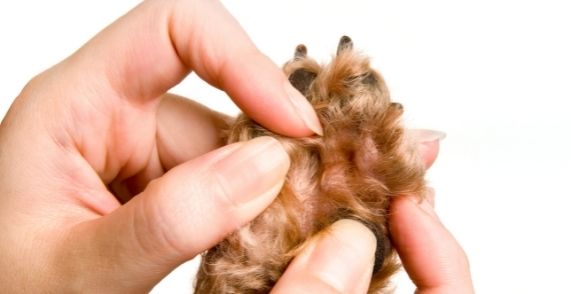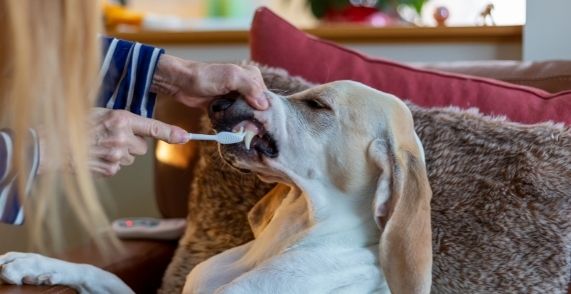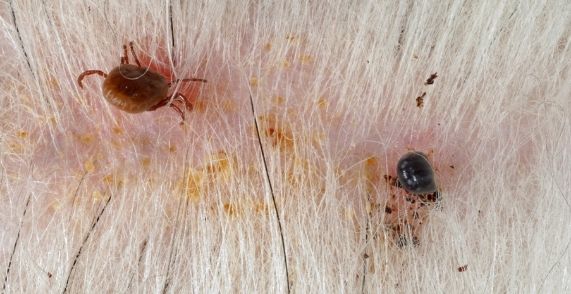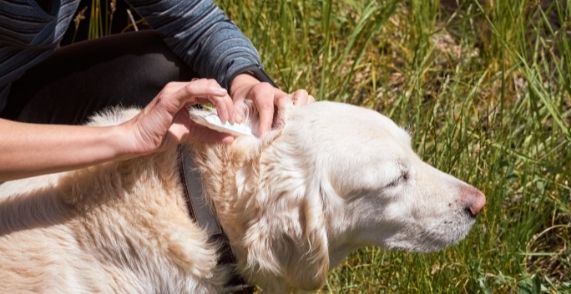Yes, washing your dog is important, but not as important as some people might think. Healthy dogs actually don’t need to be washed all that often, but humans prefer to bathe them so that they have a more pleasing smell and appearance.
Doggie bath time is actually a good time to spend with your dog, however. Although most of them don’t like to be washed, they will appreciate the contact and attention that they receive from their owners during a bath.
It’s also a good time to perform some other necessary “dog maintenance” such as cleaning the ears, checking for ticks and fleas, and brushing the teeth.
Since many dogs do not like to sit still for any of these activities, it can be a good idea to do them all at once.
Check For Foreign Objects

Dogs often run through or under trees or bushes and foreign bodies can get caught in the dog’s coat as a result. So the first thing to do is to check for any twigs or sticks that may have lodged in or under the skin.
Inspect your dog’s paws, around the neck or ears or anywhere around the rear or tail, especially larger dogs with bushy tails such as Collies or German Shepherds etc.
Left unchecked, these can cause the fur to mat around them. The dog will worry at it and probably lick the area bare, leaving it open to infection. You can avoid this with a few minutes’ attention.
Brush Your Dogs’ Teeth

Some people don’t realize that dental hygiene is as important for dogs as it is for human beings. Just like in people, dogs’ teeth can gather plaque after eating.
When plaque builds up and hardens it becomes a coarse brown substance called tartar. As tartar accumulates it can work its way under the gums and cause painful infections and gum disease.
This goes on in the mouths of dogs just like it does in people. You brush your teeth every day, probably three times. What does your dog do?
Periodontal disease is the most frequently diagnosed health problem in pets. In fact, more than 80 percent of dogs have it by the time they are 4 years old.
Periodontal disease begins when bacteria and food debris build up along the dog’s gum line.
Plaque is created and, soon after, tartar forms on the teeth. Eventually the gums swell, and pockets form that can trap bacteria and lead to more serious problems.
“Doggy breath, loose teeth, bleeding gums, mouth pain and even infections in the heart, liver and kidney are signs of advanced periodontal disease,” says Jan Bellows, DVM and owner of Hometown Animal Hospital and Dental Clinic in Weston, Fla.
“To avoid these health problems, owners must take steps to care for their dog’s teeth-much like they care for their own.”
Only one in five owners have ever attempted to brush their pet’s teeth and only 2 percent brush with enough frequency to maintain proper oral health.
So brushing your dogs’ teeth is just good dental hygiene. Most vets recommend that it be done at least twice a week to ensure your dog maintains healthy teeth and gums and keep the buildup of tartar at a minimum.
If you’ve not been doing this (and, unfortunately, many people don’t) it’s never too late to start. The dog should have its own toothbrush and special toothpaste designed for dogs.
Make sure you brush the back teeth in small circles, the same way you would your own, and brush up and down the length of the “pointy” canine teeth.
Most pet supply stores carry specially designed toothbrushes and toothpaste just for dogs. Remember that a dog’s sense of taste and smell is far more acute than that of a human and the zesty, tingly, mint taste of toothpaste designed for humans will be extremely awful to a dog.
Try brushing Rover’s teeth with Crest just once and it will likely be the last time he lets you anywhere near him with a toothbrush so best to just use the specially designed doggy toothpaste.
Check for Ticks

Ticks are nasty little arachnids (they’re eight-legged creatures like spiders, and therefore are not insects) that will latch onto your dog’s skin and make it’s blood their meal ticket.
They have a one-piece body and the harpoon-like mouth barbs attach to a host (your dog) for feeding. Crablike legs and a sticky secretion help the tick to hold on.
They are most common in wooded areas, but your dog should be checked for them regularly because they can carry a number of diseases.
The best place to look for these annoying bugs is under the collar or on the dog’s underbelly, buried in the fur. When attempting to remove a tick, the aim is to prevent the mouth section from coming off and remaining embedded in the skin.
Check For Fleas

Fleas can be found in the same places, usually under the fur. The presence of fleas can be betrayed by the sight of their droppings on the dog’s coat.
They look like flecks of pepper. The fleas themselves look like bits of brown rice. They’re about an eighth of an inch long.
They can’t simply be picked off of the dog like ticks can, but finding them will let you know its time to start the dog on a program to control and eliminate them.
Since you are washing the dog anyway as you make these checks, the simplest thing to do is…
1. Make sure you’re using a good flea & tick shampoo.
2. Use a flea spray. Make sure it has ingredients that not only kill the fleas but also their eggs. Either aerosol or pump bottle sprayers will do the job but make sure you avoid spraying near your dog’s eyes
3. You can also use a good flea powder after washing your dog for extra protection. Work it through your dog’s coat from front to back. It’s always a good idea to use the powder on your dog’s bedding as well.
4. A flea collar will help prevent more infestation. Make sure it’s a super high quality and doesn’t just protect your dog around the head and neck area.
Check the Ears

It’s always a good idea to check your dogs ears for things like excessive wax (which attract ear mites), foreign objects (such as grass clippings, tiny twigs etc) that can get caught inside – especially when your dog tends to go snooping outside in places they shouldn’t.
If your pet has ear mites, then place two drops of corn oil into its ears (an eye dropper will do the trick), massage the ear gently then clean with a cotton ball. This will suffocate the mites.
Repeat for 3 days. Regular ear bathing with oil is recommended by vets, to avoid a buildup of wax and irritants.
Pet supply stores sell special solutions for cleaning a dog’s ears. Dogs can easily get ear mites and even small insects which live in the ears and feed off the waxy secretions there.
Over time the bodies of these short-lived creatures build up and form a black, dirty substance.
Use a cotton swab dipped in a bit of this solution and then gently clean the inner ear. It may be difficult to hold the dog still for this procedure, but it doesn’t take long. And the result will be clean ears and the avoidance of potential infection and earaches.
Elise is the owner of HMD. She has spent her whole life around dogs starting from when she was growing up on her parents farm. She is a prolific writer and blogger who passionately writes about her love for her canine friends.

